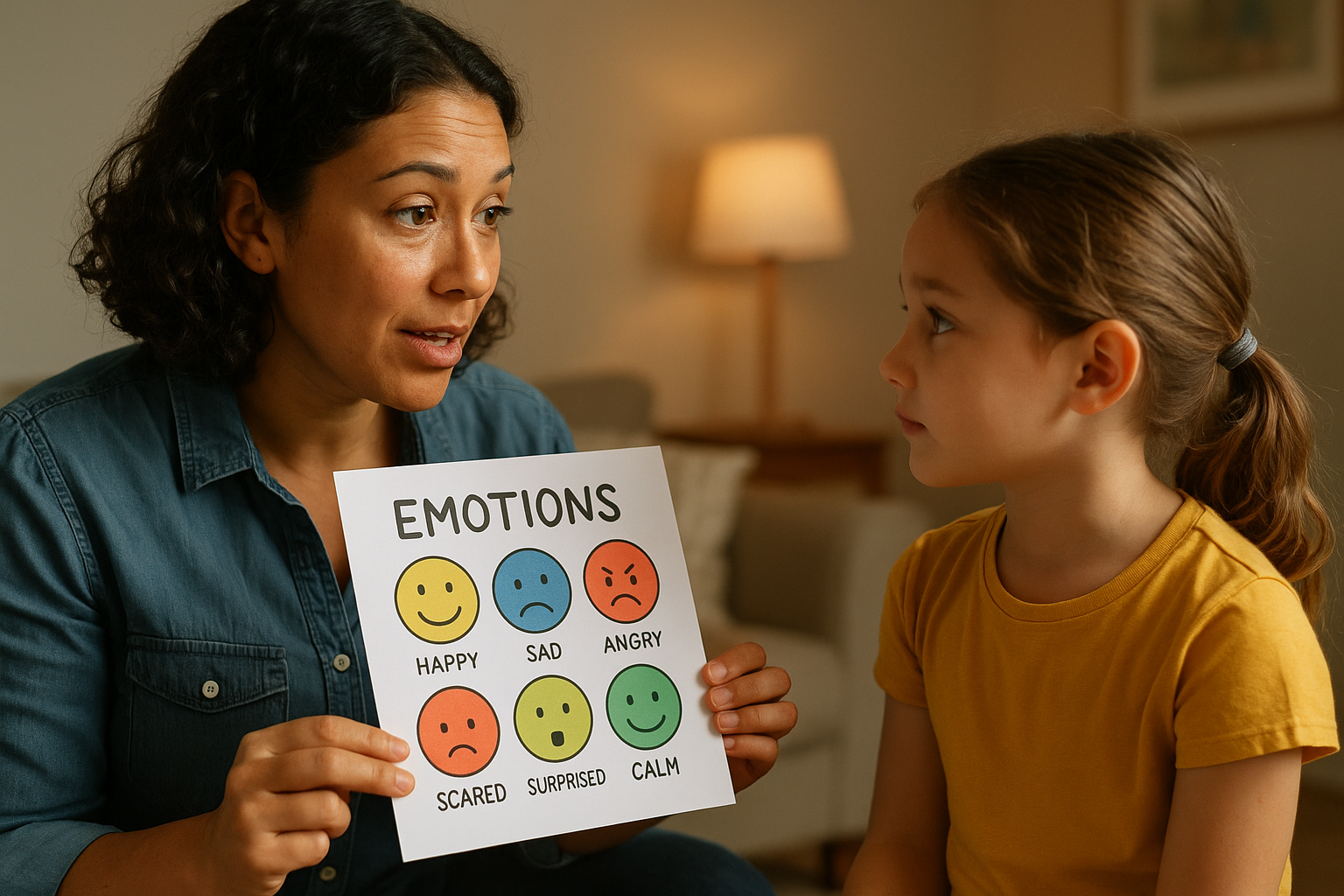Emotions are part of everyday life—but for many children, naming and understanding their feelings doesn’t come naturally. They may cry, yell, withdraw, or act out, not because they’re “bad,” but because they haven’t yet learned the language of emotions.
As a parent or caregiver, your role is to guide your child through their emotional world. When you talk openly about feelings, you help them become more emotionally intelligent, resilient, and empathetic.
Here’s how to talk to your child about emotions in ways that build trust, understanding, and lifelong emotional skills.
Why Emotional Literacy Matters
Emotional literacy is the ability to identify, understand, and express emotions in a healthy way. Children who develop this skill:
- Are better at managing stress and frustration
- Get along more easily with peers
- Have fewer behavioral issues
- Communicate more clearly with adults
- Are more empathetic and self-aware
When you help your child recognize their emotions, you’re giving them tools to express themselves rather than act out or shut down.
Start With Your Own Emotional Openness
Children learn how to handle feelings by watching how you handle yours. If you hide your emotions or explode in anger, they learn to either suppress or overreact to their own.
Instead, model emotional awareness by expressing your feelings calmly and clearly.
Try phrases like:
- “I’m feeling a little overwhelmed right now, so I need a quiet moment.”
- “I felt really happy when you gave me that drawing.”
- “I’m frustrated because we’re running late, but I’m working on staying calm.”
This shows your child that emotions are normal and manageable.
Use Everyday Moments to Name Emotions
You don’t need a big “feelings talk” to start teaching emotional awareness. Use everyday moments to point out and label emotions—both theirs and others’.
Examples:
- “You’re smiling! You look proud of your drawing.”
- “I see tears—are you feeling sad or hurt?”
- “Your friend looked upset when she dropped her toy. How do you think she felt?”
By regularly naming emotions, your child begins to connect physical sensations and behaviors with emotional vocabulary.
Teach a Wide Range of Feelings
Children often start with the basics: happy, sad, mad. But emotional intelligence expands when they learn nuanced emotions like disappointed, nervous, excited, bored, jealous, or calm.
Use books, movies, or real-life experiences to explore more complex emotions.
For example:
- “She wasn’t just sad—she looked embarrassed.”
- “You seemed frustrated when your tower fell. That’s different from being mad at someone.”
The more words your child knows, the more precisely they can express how they feel.
Validate, Don’t Dismiss
Even when a child’s feelings seem dramatic or exaggerated, they are real to them. Avoid minimizing or denying their emotions.
Instead of:
- “You’re overreacting.”
- “There’s nothing to be afraid of.”
- “Don’t be sad.”
Try:
- “I can see that this really upset you.”
- “It’s okay to feel nervous—new things can be scary.”
- “I’m here with you, even when it feels hard.”
Validation builds emotional safety and trust.
Ask Open-Ended Questions
Encourage your child to explore and express their feelings by asking gentle, open-ended questions.
Examples:
- “What made you feel that way?”
- “Can you tell me more about what happened?”
- “Where do you feel that in your body?”
- “What do you think would help you feel better?”
These questions create space for reflection and problem-solving.
Create a Feelings Chart or Wheel
Visual tools like emotion charts or wheels can help children name what they’re feeling when words are hard to find.
You can:
- Make your own chart with faces and emotion words
- Use a printable chart for daily check-ins (“Point to how you’re feeling today”)
- Keep it in a common area like the fridge or playroom
This is especially helpful for younger kids who are still learning emotional vocabulary.
Help Them Link Emotions to Actions
Once your child can name an emotion, teach them how to respond to it in a healthy way.
Examples:
- “When you’re angry, it’s okay to take a break or squeeze a pillow—but it’s not okay to hit.”
- “If you’re feeling lonely, you can ask to play or talk to me.”
- “When you’re excited, it’s great to share what you’re happy about!”
This shows that all emotions are okay—but not all behaviors are.
Use Books and Stories as Emotional Lessons
Books are powerful tools for teaching emotions. Choose stories with characters who experience emotional challenges, and talk about how they handled them.
Ask:
- “How do you think that character felt?”
- “What did they do with that feeling?”
- “Have you ever felt like that?”
Relatable stories make it easier for children to understand and apply emotional lessons.
Reassure Them That Feelings Are Temporary
Big feelings can feel overwhelming to children. Teach them that emotions don’t last forever—and that they have the power to get through tough moments.
You can say:
- “This feeling is strong right now, but it will pass.”
- “Let’s take a few breaths and check in again in a little while.”
- “You’ve handled hard feelings before, and you can do it again.”
This builds emotional resilience and helps your child trust their ability to cope.
Helping Your Child Understand Their Inner World
Talking about emotions isn’t a one-time conversation—it’s a lifelong practice. By making space for feelings, modeling emotional openness, and responding with empathy, you’re helping your child build a strong foundation of emotional intelligence.
That foundation will serve them in school, friendships, future relationships, and in understanding themselves.
When you give your child the tools to talk about how they feel, you’re not just teaching them to manage emotions—you’re giving them the language to connect more deeply with the world around them.
